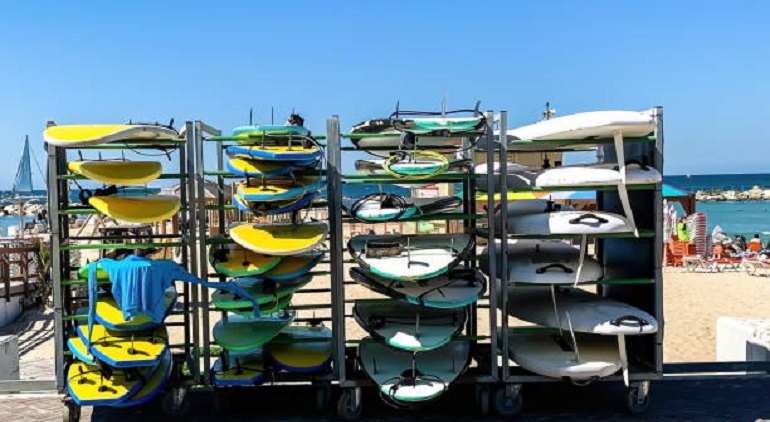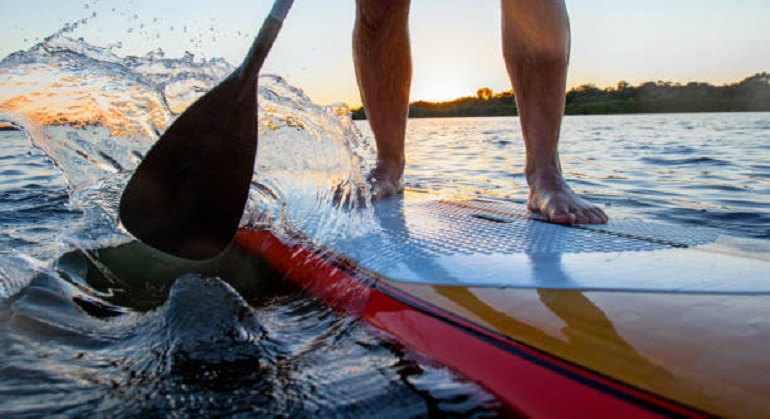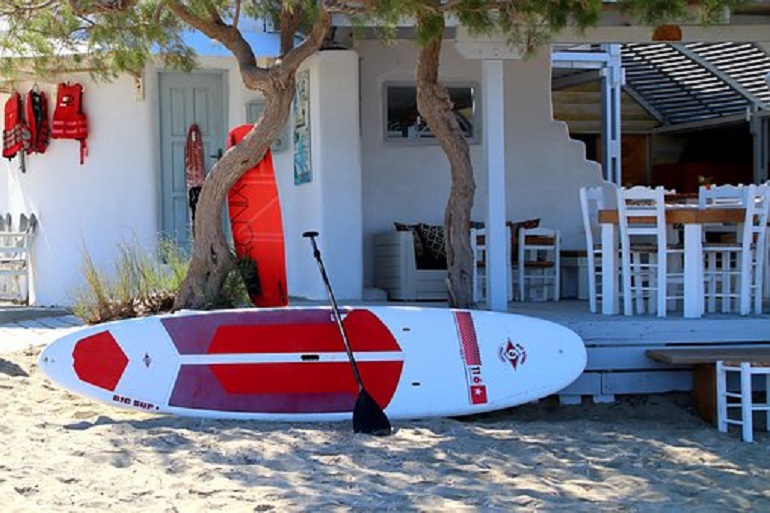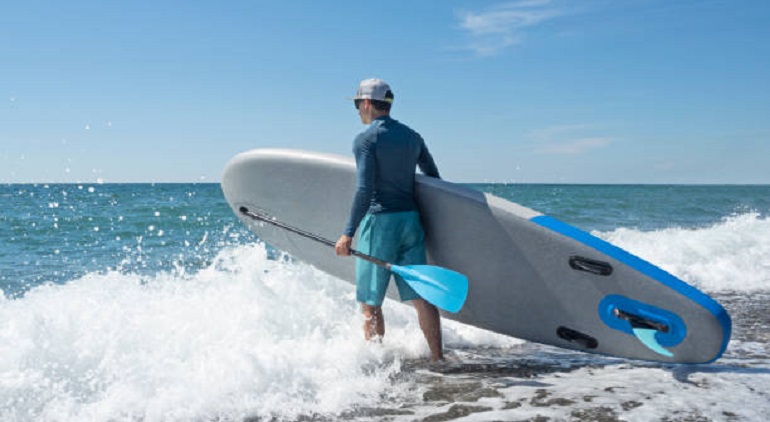Paddle boarding is an accessible and fun way to get out on the water. It can be done by all age groups and can be enjoyed by the whole family.
Paddle boards have a wide range in price and are a fantastic form of exercise. It is also a great way of burning some calories!
People use the big, stable surface of paddle boards for many different activities. They are not just simply for sailing about in a straight line.
Many water sports activities, such as SUP yoga, and SUP touring, are very common. People do their stretches and meditations or load up for trips out to islands or fishing, respectively.
It’s Easier Than You Think
Learning to stay balanced and start paddling isn’t all that hard, provided you have the right equipment and have been through a beginner’s guide. With a little practice and some patience, you will be able to dig that oar in and be able to paddle faster in no time.
Your first SUP outing might have you knee-deep in the cold water here and there but before long, you will have mastered the paddling techniques. As they say, practice makes perfect.
If you’re interested in learning how to stand up paddle board, enjoying the freedom of the open water, and doing a full-body workout, dig into this article and read on.
Variety Is the Spice of Inflatable Paddle Boards
Stand-up paddle boards come in many different shapes and sizes, just like the paddle boarders that ride them. They are suited to many diverse uses and skill levels.

There is something out there for everyone, from the aspiring yogi to the three-day camping trip adventurer. No matter your skill level or requirement, there is a SUP for you.
Inflatable SUP Paddle Board
These are definitely the industry favorite and most common type, but for good reason. They are durable, incredibly transportable, can be inflated and deflated in minutes, and come in all shapes and sizes.
Best stand-up paddle boards fit into a simple board bag and can be quickly thrown into the trunk of a car or carried with a carry handle for easy transport to your favorite body of water.
Inflatable SUPs are the perfect way to start practicing, their lightweight design and forgiving surfaces make for easy movements around the board.
For a beginner’s first time, the soft tops of an inflatable paddle board are forgiving when you lose your balance and fall. The best paddleboards for beginners are often covered with soft, grippy materials that soften the blow.

Even for advanced riders, inflatable SUPs are the first choice. They are easy to transport across the land, offer loads of stability, and are just as durable, if not more so, than their solid counterparts. With just a few minutes of pumping, the perfect SUP is ready to launch off your nearest beach.
Solid SUP
Fiberglass Stand-Up paddle boards do have their uses. The solid board construction is great for surfing and racing. They aren’t as durable as an inflatable stand-up paddle board and are prone to chips and dinks from debris under the water.

These are a board designed for people who compete in the water sport, rather than just want a recreational bit of sports gear. They are a lot harder to transport due to the solid nature of the board and, although they are light, require a roof rack or van to get around.
The benefits of a solid board are all in maneuverability. In choppy waters or adverse conditions, the hard core of fiberglass will maintain balance and help you stay standing. The construction will keep the board forward and stable.
All-Around Paddle Board
These are paddle boards that are made for the masses. They have a gently rounded displacement hull nose, rounded or blunt tail, and a wider design than other styles.
The broad form makes standing up a lot easier. The increased board surface in contact with the water provides a remarkably steady platform to balance and paddle from.
All-Around paddle boards are perfect for beginners and experienced riders alike. They have plenty of room to carry gear and can be ridden by multiple paddlers. They are the ideal way to explore your local lakes and ocean.

The forgiving shape of the board allows it to ride over, chop and surf without issue. If it is your first time off flat water, they are a fantastic way to improve confidence. The issue is their lack of speed and maneuverability. They’re perfect for SUP yoga and carrying fishing gear, but maybe not so much for longer journeys.
Touring Paddle Boards
For long distances and more advanced riders, the touring paddle board is your friend. A pointed nose and tail provide more speed and momentum from every forward stroke. As you paddle, the tip pushes through the water and keeps you moving straight.
A touring paddle board is usually slightly slimmer down the middle that the All-Around alternative. This gives the SUP less balance but with the right technique, this isn’t a problem.
Getting Geared Up to SUP
Ever heard the phrase “all the gear and no idea”? Well, our aim is to ensure you have all the gear and all the ideas. You will need a few articles of equipment to make sure you’re enjoying your SUP safely.
Stand-Up Paddle Board
Obviously. You’re not going to get very far without one of these. Just make sure it suits you and your skill level. You want a board that is fit for purpose and suited to your body and planned day out. Check the board guide earlier for tips.

Sup Paddle
You can try and paddle with your hands, but I wouldn’t recommend it. Get yourself a reliable paddle. They are usually made of lightweight materials like aluminum, fiberglass, and even carbon fiber.
Paddles come with a t-grip at the top of the shaft and a blade at the base. By driving your weight through the paddle, you are able to propel the nose forward through the water. With a few strokes on your paddle, you’ll be powering along in no time.
Leash
An ankle leash keeps you attached to your SUP even when you slip off into the water. A fall is inevitable, even the pros can’t stay standing all the time.
Some models of SUP come with a paddle leash as well. These ensure that your paddle doesn’t float away if you can’t hang onto it.
PFD (Personal Flotation Device)
These are actually very important for beginners and advanced riders alike. It is easy to forget how tired you may have become whilst paddling out into the water. All it takes is one slip and fall, and you’ll have to swim and pull your weight out of the water and back onto your SUP.
Having a safety device like a life jacket will keep you afloat without having to kick and swim your way back to your SUP. Safety equipment is your friend, it may be slightly uncomfortable, but it could save your life.
Safety Whistle and Light
If you’re in trouble, you need to make yourself visible to the coast guard as quickly and easily as possible. By drawing attention to yourself with sound and light, you can ensure a speedy and efficient rescue.
A coast guard is usually situated at a designated swimming area. If you have a light, whistle, and personal flotation device, you drastically improve your chances of rescue if things go a little wrong.
Proper Clothing
Dress for the day you’ll be paddling in. It is good to remember that just because you’re on the water, you can still get sunburnt. In fact, due to UV rays bouncing off the surface of the water, you will actually burn twice as fast. Get high SPF, or keep that bare skin covered.
The same goes for the cold. Wind can quickly drop your body temperature down and add wind chill. You don’t want to be stuck out in the water, freezing.
How to Size Your Sup Paddle
In general, it is a simple process of taking the rider’s height and adding 9 or 10 inches. If this doesn’t work for you, try adding or taking away a little to the paddle’s shaft.
Getting to Grip With Paddling Techniques
Here are a few tips for beginners. I can walk you through a few basic tips to keep your nose straight and core centered on your board. There may even be helpful tips for an advanced move or two.

How to Paddle Forward
The first step is standing up on your stand-up paddle board. Once you have this down, you can work on your forward stroke.
Standing Up
- Using the grab handle at the center point of the board, carry yourself onto the center of the board and lie your torso along the deck from nose to tail. Lie on your chest and put your arms under you.
- Push yourself up in the center of the SUP until you are on your knees with either arm on each side of your feet.
- From the kneeling position, place one foot forward, then keep your core muscles tensed, bring both feet parallel, push up with one hand, and move into the standing position.Tips
- Don’t be afraid to use your arms for balance and keep your feet about hip-width apart. Face straight down the board and keep your knees slightly bent. Feel the board stabilize under your feet.
Forward Stroke
- Angle the blade forward from the shaft and grasp the T-Bar with one hand and the shaft with the other. Your top hand will push, and your other hand will pull and guide the paddle.
- The correct hand positions can be determined by lifting the paddle above your head. Your hands want to be shoulder-width apart at a 90-degree angle.
- Stand central on your paddle board and dip the SUP paddle into the surf. Have your knees bent and by engaging your core strength and pulling the paddle back with a sweep stroke, you will propel yourself forward.Tips
- Focus on keeping your arms straight and pushing down on the paddle grip whilst you twist with your torso. A long sweep stroke will make the most distance with the least effort.
Reverse sweep stroke
This is to slow down, reverse, and rotate the board in the opposite direction. It is essentially the opposite of the forward stroke.

- Push your paddle into the water behind your paddle board.
- Keeping your knees soft, legs facing forward, arms straight, and pulling with your torso, pull the paddle forward in the water, moving the board with the reverse stroke.
- The reverse stroke should slow you down, and begin rotating the stand-up paddle board.
Sweep Stroke
This is a technique for when you want to spin the paddle board.
- Submerge the paddle at the front edge of the SUP. To turn right, submerge the paddle on the left side, and the right side to turn left.
- Bend your legs slightly, and rotate your shoulders as you focus on pulling your arm and paddle around the SUP in a wide arc. Your stand-up paddle board should shift easily. Switch sides to shift the opposite way.Tips
- You can stand further back on the paddle board, above the fins, and use your paddles to spin the board more quickly. Make sure to keep the board flat.
Draw Stroke
A draw stroke pushes your whole SUP sideways and is great for pulling parallel alongside something without spinning.

- Point your head and shoulders in the direction you want to push away from and push your paddle into the water.
- Have the paddle parallel to the board and use your core to pull the paddle towards you moving the paddle board towards your paddle.
A Few Last Points on Paddle Boarding
I’m sure by now you know what is SUP. So, head out and give paddle boarding a try. It can be enjoyed by everyone, and with my few simple paddle-boarding tips, you should be able to pick it up in no time at all.
Paddle boarding has been a hit all over the world, and you can pick yourself up a cheap paddle board for a reasonably low price. You can easily pack your board into a board bag and head out to wherever you may want to have an adventure. As a beginner, you can go for lightweight iSUP paddle board options like the Lidl Paddle Board or an all-inclusive Body Glove paddle board.
Give paddle boarding a go, put one foot in front of the other, and see where your board (and the wind) takes you.
0 Comments